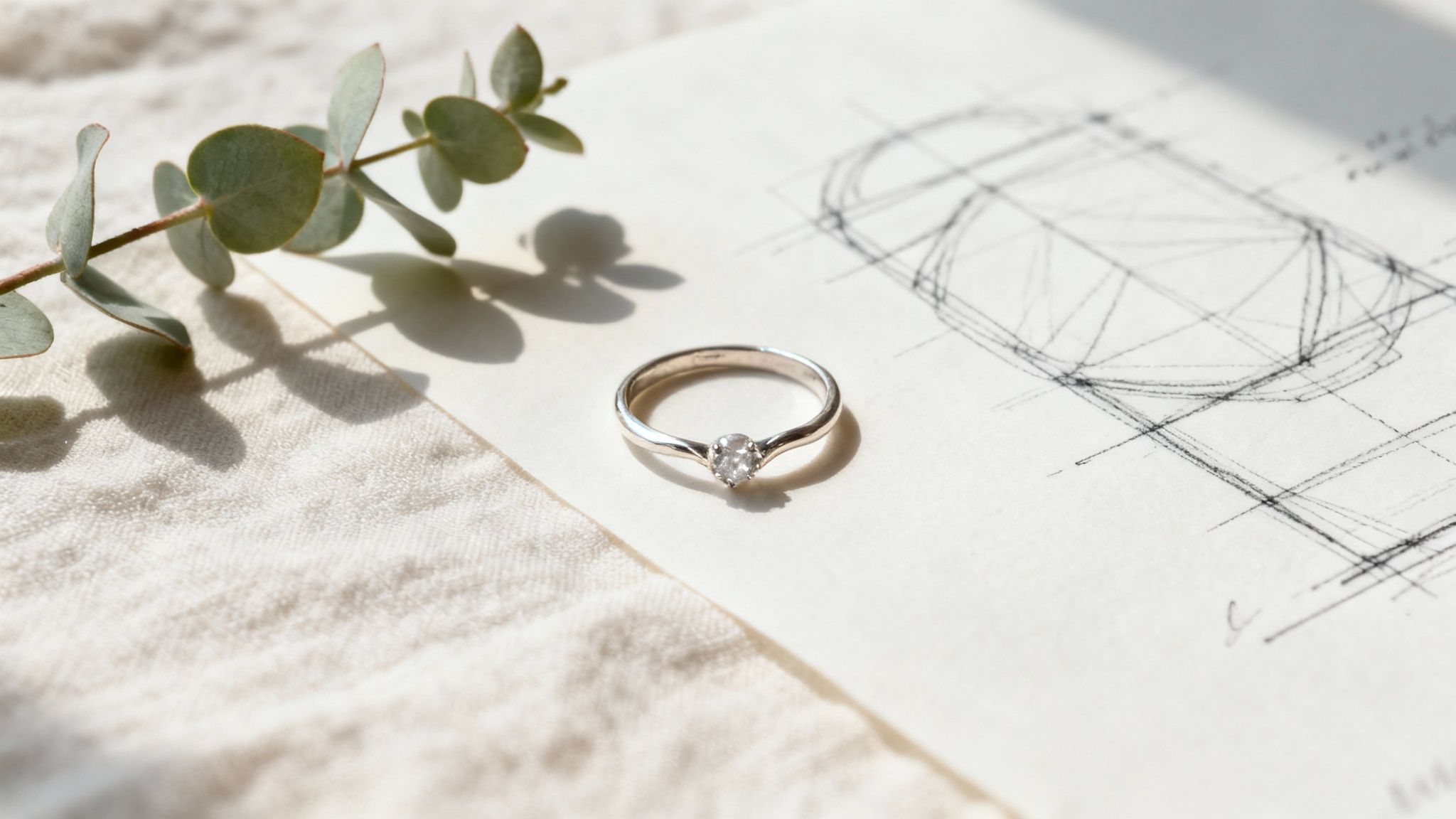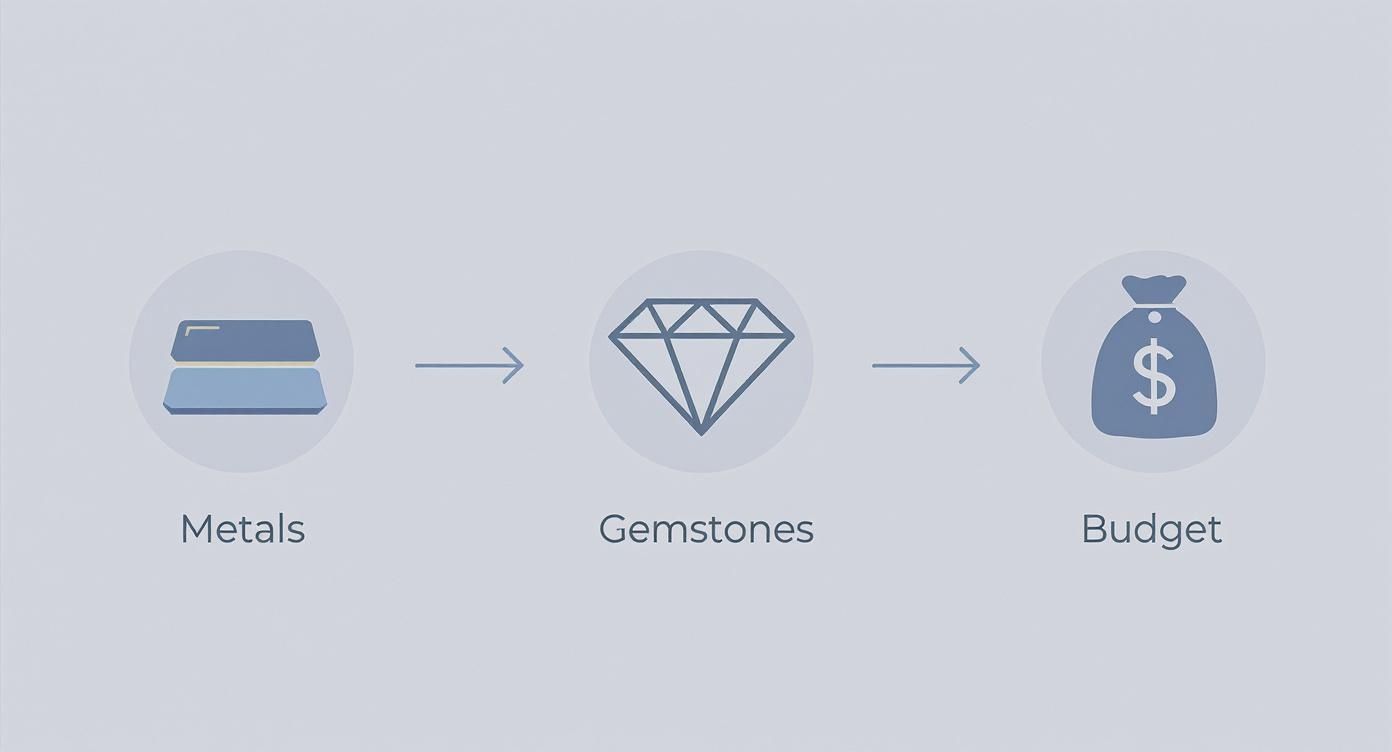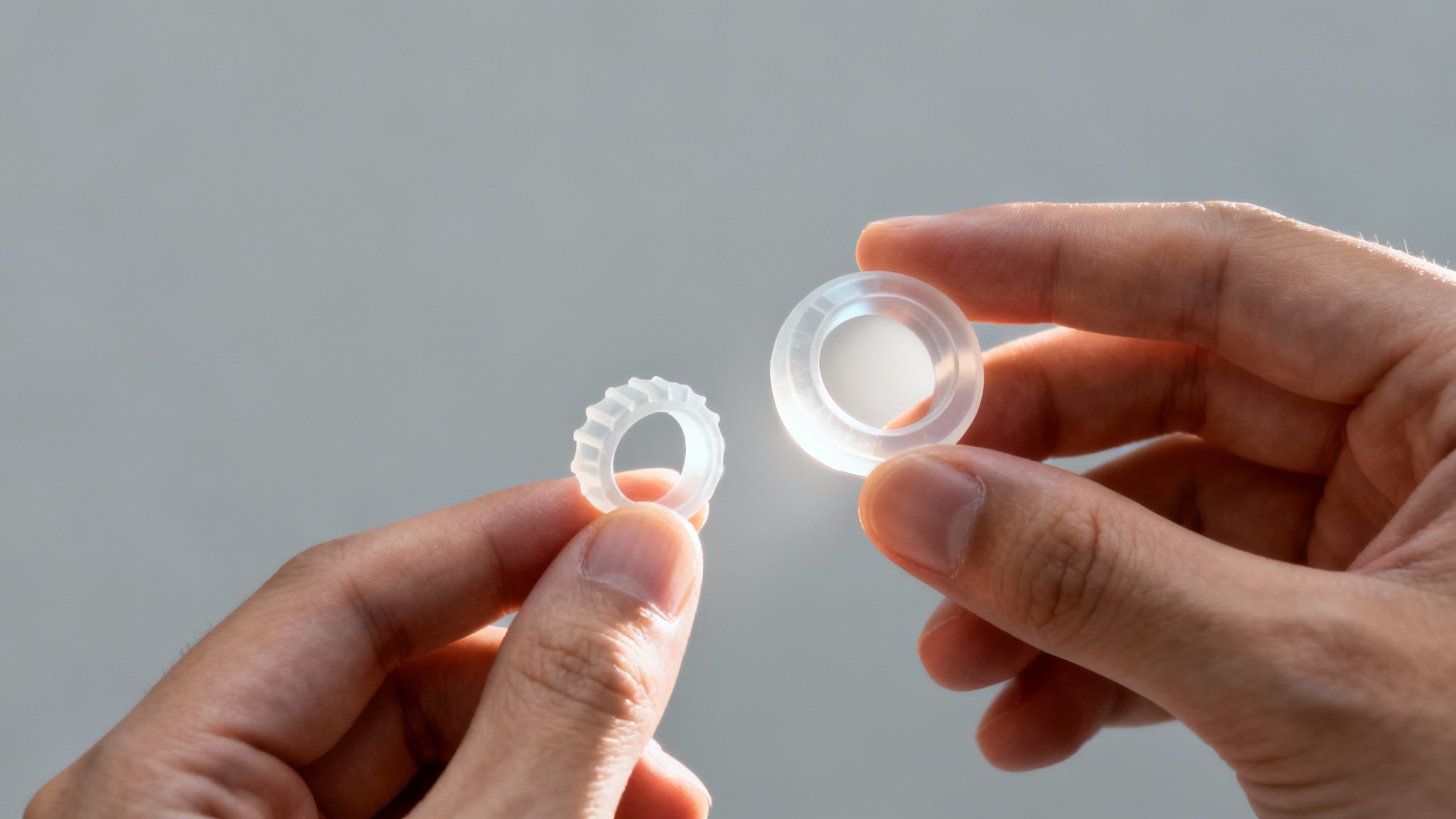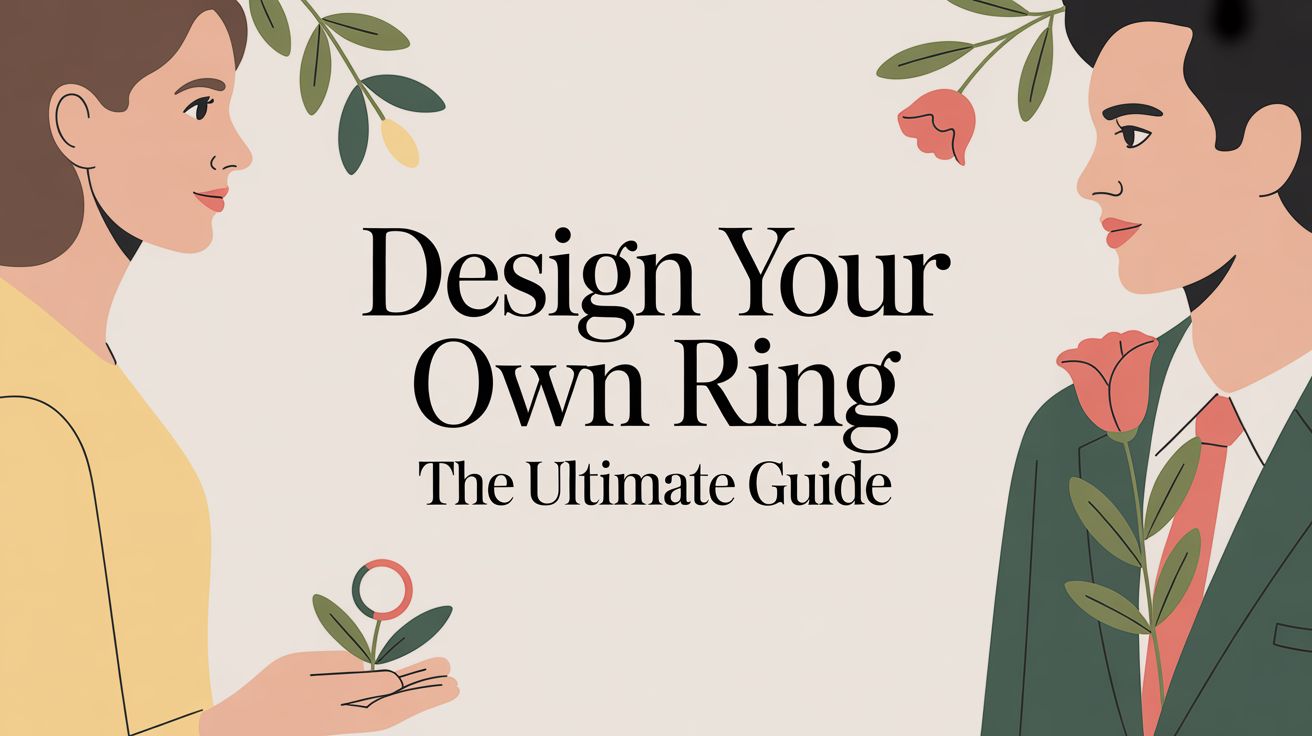When you design your own ring, you're doing more than just picking out a piece of jewellery. You're crafting a personal story, cast in precious metal and stone—turning a simple idea into an heirloom that captures your unique journey.
The Unmatched Appeal of a Bespoke Ring

Stepping away from mass-produced, off-the-shelf options gives you the chance to create something genuinely one-of-a-kind. A custom-designed ring is a powerful statement, a symbol of a milestone, a relationship, or a personal achievement. It immediately becomes a conversation starter with a story that only you can tell.
The process itself is incredibly rewarding. When you're involved from the very first sketch to the final polish, you forge a real emotional connection to the piece. This is your chance to make sure every curve, stone, and detail aligns with your style and values, creating a future heirloom to be treasured for generations.
Why Bespoke is Becoming the New Standard
These days, more and more people are looking for authenticity and meaning in what they buy, especially for something as significant as an engagement or wedding ring. That desire to have a direct hand in the creative process has really shaken up the jewellery industry.
This shift is also driven by a growing awareness around sustainability and ethics. The option to use lab-grown diamonds, for instance, has surged in popularity. In fact, over 70% of millennials now prefer them for engagement rings, which says a lot about the move towards more conscious choices. You can explore more about how jewellery industry tastes are changing and see the statistics for yourself.
By designing your own ring, you take control of the narrative. You select the materials, perfect the silhouette, and embed your personal story into its very structure, creating a piece that is unequivocally yours.
This guide will walk you through every step of this fulfilling experience, showing you just how accessible and straightforward it can be to bring your vision to life. From capturing that first spark of inspiration to approving the final design, we'll give you the know-how to create a masterpiece that perfectly tells your story.
Finding Your Inspiration and Defining a Vision
Every unforgettable custom ring starts not in a workshop, but with a spark of an idea. This first, most creative phase is all about gathering inspiration and turning those fleeting thoughts into a solid vision. This is where you become the architect of your piece.
Inspiration is everywhere. You might find it in the elegant geometry of an art deco building, the organic flow of a twisting vine, or the intricate details of a vintage family heirloom. Don't just look at other jewellery; pay attention to patterns, textures, and shapes in the world around you that capture the feeling you want the ring to have.
A fantastic way to organise these ideas is with a digital mood board. A platform like Pinterest is perfect for this. Pin images of rings you love, but also include pictures of architecture, art, nature, and fashion that match your aesthetic. This visual collection becomes an invaluable tool for showing your jeweller exactly what's on your mind.
Turning Ideas into a Practical Design
Once you have a collection of inspirations, it's time to ground them in reality. A ring is meant to be worn every day, so its design has to suit the wearer's life. Thinking about these practical elements early on prevents disappointment later and ensures the final piece is both beautiful and functional.
Think about the wearer’s daily routine. Do they have an active job or a hobby that might expose the ring to knocks and bumps? If so, a low-profile setting, like a bezel, might be a smarter choice than a high, prominent claw setting. Durability becomes a key part of the design conversation.
Equally important is their personal style. Are they drawn to minimalist, clean lines, or do they prefer ornate, detailed pieces? The answers will guide every decision, from the width of the band to the choice of finish. You can find more ideas by exploring a gallery of custom engagement ring designs to see how different styles come to life.
The goal isn't to arrive with a perfect technical drawing. It's about defining the core elements and the overall feeling you want the ring to convey. Your jeweller is your expert partner in translating that feeling into a workable, beautiful design.
To help you get your thoughts in order before your first consultation, it’s a great idea to think through the main components of the ring. This simple table can help structure your ideas.
Key Design Elements to Consider
| Design Element | Key Questions to Ask Yourself | Example Ideas |
|---|---|---|
| Overall Style | Does it feel classic, modern, vintage, or bohemian? | Minimalist solitaire, ornate Victorian cluster, geometric art deco. |
| Metal Choice | What colour best suits their skin tone and existing jewellery? | Warm yellow gold, cool and bright platinum, romantic rose gold. |
| Central Stone | What shape and type of stone are they drawn to? | Classic round brilliant diamond, elegant oval sapphire, unique pear-cut emerald. |
| Key Details | Are there any special touches to include? | Hidden engraving, a delicate pavé band, intricate filigree details. |
Having answers to these questions—even if they're just starting points—will make your first meeting with a designer incredibly productive. It gives them a clear direction and helps turn your vision into a reality much faster.
Choosing Your Metals and Gemstones
This is where the personality of your ring really starts to take shape. The materials you choose will define its look, feel, and how it wears over a lifetime, so it’s worth understanding the options. When you design your own ring, picking the right metal and gemstone is a deeply personal choice that balances style with real-world practicality.
The precious metal is the foundation of the whole piece. It sets the colour palette and has to be durable enough for whatever life throws at it. Think about the wearer’s lifestyle—someone with a very active, hands-on job might benefit from a harder, more scratch-resistant metal.
This decision also steers the overall cost, helping you allocate your budget where it matters most. Whether you love the cool, contemporary feel of platinum or the classic warmth of yellow gold, each metal has its own character.
A Guide to Popular Precious Metals
Choosing a band is about more than just colour. Each metal brings a unique mix of durability, weight, and maintenance needs that will influence how the ring feels on the hand and how it looks years down the line.
Here’s a quick rundown of the most common choices:
- Platinum: A premium choice, known for its brilliant white lustre and serious durability. It’s naturally hypoallergenic and dense, giving it a satisfying heft. While it can scratch, the metal is just displaced, not lost, and it develops a beautiful, unique patina over time.
- Yellow Gold: The timeless, classic option. Available in different purities (like 9ct and 18ct), its warm glow looks fantastic against a huge range of skin tones and gemstone colours. It's a bit softer than platinum but has a traditional appeal that never fades.
- Rose Gold: A beautiful, romantic alternative with a warm, pinkish hue that comes from its copper alloy. It has a vintage-inspired feel and is surprisingly durable. Its unique colour can really make diamonds and coloured gemstones pop.
- White Gold: A hugely popular and more affordable alternative to platinum. It’s typically alloyed with white metals and then plated with rhodium to give it a bright, reflective finish. This plating might need to be redone every few years to keep it looking its best.
Selecting the Perfect Gemstone
The gemstone is the heart of your ring. While diamonds are the go-to, there’s a whole world of vibrant alternatives waiting to be discovered. Your decision here should be all about the wearer's personality and style, and perhaps your ethical considerations, too.
For diamonds, getting to grips with the ‘Four Cs’—Cut, Colour, Clarity, and Carat—is key. The cut dictates its sparkle, colour is about the absence of yellow, clarity measures imperfections, and carat is simply its weight. A good jeweller can help you find the perfect balance to get a stunning stone that fits your budget.
But don't overlook coloured gemstones. Think of deep blue sapphires, rich green emeralds, or fiery red rubies. These stones are a fantastic way to add personal meaning and a splash of unique colour.
These days, ethically sourced and sustainable options are a huge priority for many. Lab-grown diamonds, for example, are physically and chemically identical to mined diamonds but offer incredible value and a clear conscience. They’re a brilliant choice for modern bespoke jewellery.
The care people take in these choices reflects a bigger trend in the UK, where buyers are looking for more than just a pretty object. The UK jewellery market is increasingly driven by a desire for long-term value, ethical sourcing, and true craftsmanship. Rings have become the largest market segment, making up a 36.3% revenue share, largely because of their cultural importance and the fact they’re worn every day. You can read more in the latest UK jewellery market report. For more specific advice on wedding jewellery, have a look at our guide on how to build your wedding ring.
Translating Your Vision with CAD Design
This is where the magic really starts to happen. All those sketches, inspiration photos, and conversations come together in a tangible, three-dimensional preview of your ring. We use Computer-Aided Design (CAD) to bridge the gap between your imagination and the jeweller's workbench. It’s how you get to see and approve every detail with incredible precision before we even touch a piece of precious metal.
A skilled designer will use specialised software to build a detailed 3D model of your ring. This isn't just a flat drawing; it’s a fully realised digital version you can spin around and view from every conceivable angle. Think of it as a crucial blueprint that ensures we all share the exact same vision for the final piece.
The process is also highly collaborative. You’re not just a spectator; you become a co-creator, giving direct feedback on the photorealistic images (we call them "renders") that we'll send over. This is your moment to fine-tune every last detail and perfect the design.
What to Look for in Your CAD Renders
Getting that first set of renders in your inbox is always exciting. To make the most of this stage, you’ll want to look at specific elements critically—not just for how the ring looks, but how it will actually feel and function when you wear it every day.
Here are the key aspects to scrutinise:
- Proportions and Scale: How does the band's width look next to the centre stone? Does the ring's overall size feel right for the hand it’s designed for?
- Setting Height: Take a good look at the side profile. Is the main stone set too high, where it might snag on jumpers, or is it too low? The right height is a careful balance of beauty and practicality.
- Band Thickness and Shape: Check the band's thickness from all angles. A band that’s too thin might not hold up to long-term wear, while one that’s too chunky could feel uncomfortable between the fingers.
- Intricate Details: Zoom right in. If you have any engraving, filigree, or pavé stones, make sure they match what you envisioned and are clearly defined in the model.
This digital checkpoint is your most important tool for preventing surprises down the line. Be honest and specific with your feedback. A simple adjustment in the CAD model takes minutes, but changing something in the final metal piece can be complex and costly.
When you communicate your adjustments, clarity is key. Instead of saying, "make the band bigger," try something more specific like, "could we increase the band's width from 2mm to 2.5mm?" Giving precise feedback helps the designer nail your changes accurately and gets us one step closer to the perfect digital blueprint for your ring.
This infographic shows the fundamental steps of selecting your materials, which directly influences the CAD process.
As the visualisation illustrates, balancing your choice of metals and gemstones within your budget is the first critical decision that informs the entire design, including the subsequent CAD modelling.
From Digital Model to Physical Form

This is where your design leaves the screen and takes its first real step into the physical world. Once you’ve signed off on the CAD renders, we bring that file to life. It’s a hugely exciting moment—the first time you can actually see, touch, and even try on your vision before we commit to precious metal.
The process kicks off with a high-precision 3D printer. Using this, we create a perfect replica of your ring, usually from a specialised wax or resin. This isn't just a rough approximation; it's an exact one-to-one scale model of the digital design you perfected. Suddenly, it’s a tangible object you can hold in your hands.
This wax model is the ultimate pre-production check. You can slide it onto your finger, get a real sense of its weight and proportions, and make absolutely sure the comfort and fit are spot on. It’s your final chance to notice anything that doesn't feel perfect. Maybe the band feels a touch wider than you pictured, or the setting sits higher than you’d like. Small adjustments are still easy at this stage, ensuring the final piece is flawless.
The Art of Lost-Wax Casting
With the green light on the wax model, we move to a fascinating process that blends modern tech with a craft thousands of years old: lost-wax casting. This time-honoured technique is what will transform your design from a wax prototype into your chosen precious metal.
It's a process that's equal parts art and science, demanding immense skill and precision from our goldsmiths. Here's a quick look at how it all comes together:
- Creating the Mould: Your wax model is carefully set inside a flask, which is then filled with a fine, plaster-like investment material. Once this sets hard, it creates a perfect, heat-resistant mould of your ring.
- Melting the Wax: The flask is fired in a kiln. The wax inside melts and drains away, leaving behind a perfectly detailed, hollow cavity in the exact shape of your ring—this is why it's called "lost-wax."
- Casting the Metal: Molten precious metal—be it platinum, gold, or your chosen alloy—is poured into the empty cavity, filling every single tiny detail of the mould.
- Revealing the Ring: After the metal cools and solidifies, the investment mould is broken away, revealing the raw casting of your ring for the very first time.
This critical step is where your ring is truly born. It will still be in a rough, unpolished state, but all the fundamental elements you so carefully planned—the shape, the settings, the intricate details—are now permanently cast in metal.
From here, your ring moves into the final stages of hands-on craftsmanship. It’s a brilliant example of how the journey to design your own ring marries cutting-edge digital accuracy with the enduring artistry of traditional jewellery making to create something truly special.
Applying the Finishing Touches of a Master Jeweller
https://www.youtube.com/embed/Q7-I96E4fzQ
The raw casting is just the beginning. The final stage is where true artistry and precision come together, transforming a piece of metal into a masterpiece. This meticulous finishing work is what separates a good ring from an exceptional one, and it's all done by a skilled jeweller’s hands.
It starts with the delicate and highly skilled task of stone setting. This isn’t about just placing a gem in a hole; it’s a craft that ensures each stone is secure, level, and positioned to catch the maximum amount of light. The chosen setting style—be it a classic claw, a modern bezel, or sparkling pavé—ultimately dictates the ring’s final character and brilliance.
Bringing Out the Brilliance
Once the stones are set securely, the ring undergoes its final polish. This is a multi-step process using progressively finer compounds to buff the metal, removing any tiny imperfections left over from casting and setting. The goal is a flawless, mirror-like lustre that makes the metal gleam.
This is also the stage for adding other custom textures, which can completely change the ring’s personality.
- Matte Finish: A sophisticated, non-reflective surface for a modern, understated look.
- Engraving: Intricate patterns or personal messages hand-carved into the metal.
- Hammered Details: A rustic, artisanal texture created by carefully tapping the surface.
This final stage of hands-on craftsmanship is a testament to the blend of traditional skill and modern innovation that defines the UK jewellery market. Consumers are increasingly seeking out this level of personalisation and quality. This trend is a key driver behind the market’s projected growth, which is forecast to expand at a CAGR of 5.93%. You can learn more about the latest UK jewellery market trends and competition forecasts here.
Each of these finishing options adds to the unique story your ring tells. For an in-depth look at just one part of this crucial process, you can explore our detailed guide on how to professionally polish a ring to perfection.
This expert completion ensures that when you design your own ring, the final piece isn't just made—it's masterfully finished.
Your Ring Design Questions, Answered
Starting a bespoke jewellery journey is exciting, but it's completely normal to have a few questions. From timelines to budgets, understanding the practical side of things makes the whole process smoother and a lot more fun.
How long does it take to make a custom ring?
One of the first things everyone wants to know is the timeline. From our first chat to you holding the finished ring, the entire process usually takes between 6 and 12 weeks.
This gives us the time we need to get everything perfect—finalising the design, casting the metal, meticulously setting the stones, and applying the final polish. It's always a good idea to start the conversation a few months before you need the ring, especially if it’s for a specific date.
Is a bespoke ring more expensive?
It's a common myth that 'custom' automatically means more expensive. The reality is, a bespoke ring is designed to fit your budget perfectly.
Because you have total control over every detail—the type of metal, the size of the gemstone, the complexity of the design—we can focus your budget on what matters most to you. It's about creating your ideal ring without any hidden costs or compromises.
What if I don't like the first design?
This is exactly what the CAD (Computer-Aided Design) stage is for. Think of it as our digital drawing board where we refine everything.
We expect and encourage your feedback. This is your chance to ask us to tweak proportions, adjust the setting height, or change small details. Most designers, including us, include a set number of revisions to ensure you are 100% happy before a single gram of metal is cast.
This back-and-forth collaboration is key. It guarantees the final piece is exactly what you had in mind, turning your idea into something real you can treasure forever.
For expert guidance on your bespoke jewellery project or to restore a cherished heirloom, trust the master jewellers at Opulence Jewellery Services. Visit us in Hatton Garden or start your journey online.

